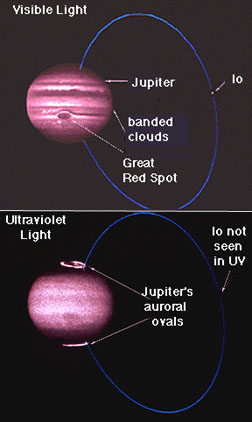

Jupiter has quite a different appearance in ultraviolet light. If you look very carefully, you will see that the bands of clouds are no longer defined and the Great Red Spot has almost disappeared. In fact, the moon Io has totally vanished. You cannot see Io in ultraviolet light.
But the most spectacular difference is the appearance of a crown of light around Jupiter's north pole. Jupiter has an aurora. If you just finished looking at the view of the Earth's aurora, you cannot help but notice the similarity between the crown of light on Earth and the one on Jupiter. On Jupiter, the aurora glows in ultraviolet light. Charged particles, ions and electrons, with high energies, precipitate into Jupiter's atmosphere. They collide with the atmospheric gases which are mostly molecular and atomic hydrogen. The emissions that result from these collisions are in the ultraviolet.
Jupiter's aurora cannot be seen from the surface of the Earth. Earth's atmosphere absorbes light at these wavelengths.
This picture of Jupiter's aurora
was taken by the Hubble Space Telescope from its position above the Earth's
absorbing atmosphere. Pictures like this one are helping
scientists to understand what causes the aurora at Jupiter.
Images from the Hubble Space Telescope, WFPC2